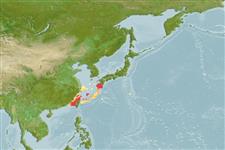Environment: milieu / climate zone / Tiefenbereich / distribution range
Ökologie
seewasser demersal; ozeanodrom (Ref. 51243). Temperate; 32°N - 23°N
Western Pacific: Hokkaido to the East China Sea.
Size / Gewicht / Alter
Geschlechtsreife: Lm ? range ? - ? cm
Max length : 30.0 cm TL Männchen/unbestimmt; (Ref. 56557); max. veröff. Gewicht: 77.70 g (Ref. 124713)
Commercially cultured in Japan. Juveniles associate with drifting seaweed (Ref. 12114, 12115).
Life cycle and mating behavior
Geschlechtsreife | Fortpflanzung | Ablaichen | Eier | Fecundity | Larven
Masuda, H., K. Amaoka, C. Araga, T. Uyeno and T. Yoshino, 1984. The fishes of the Japanese Archipelago. Vol. 1. Tokai University Press, Tokyo, Japan. 437 p. (text). (Ref. 559)
IUCN Rote Liste Status (Ref. 130435: Version 2025-1)
Bedrohung für Menschen
Harmless
Nutzung durch Menschen
Fischereien: hoch kommerziell; Sportfisch: ja
Tools
Zusatzinformationen
Download XML
Internet Quellen
Estimates based on models
Preferred temperature (Ref.
123201): 21.4 - 24.7, mean 22.7 °C (based on 26 cells).
Phylogenetic diversity index (Ref.
82804): PD
50 = 0.5312 [Uniqueness, from 0.5 = low to 2.0 = high].
Bayesian length-weight: a=0.02754 (0.01723 - 0.04404), b=2.94 (2.80 - 3.08), in cm total length, based on LWR estimates for this species & (Sub)family-body (Ref.
93245).
Trophic level (Ref.
69278): 2.8 ±0.39 se; based on food items.
Widerstandsfähigkeit (Ref.
120179): mittel, Verdopplung der Population dauert 1,4 - 4,4 Jahre. (Assuming tm=2).
Fishing Vulnerability (Ref.
59153): Low vulnerability (20 of 100).
🛈
Climate Vulnerability (Ref.
125649): High to very high vulnerability (73 of 100).
🛈
Nutrients (Ref.
124155): Calcium = 40.3 [15.3, 103.8] mg/100g; Iron = 0.436 [0.167, 1.063] mg/100g; Protein = 17.4 [15.2, 19.7] %; Omega3 = 0.467 [0.195, 1.057] g/100g; Selenium = 14.7 [7.1, 35.6] μg/100g; VitaminA = 9.6 [2.4, 40.2] μg/100g; Zinc = 0.598 [0.401, 0.975] mg/100g (wet weight);
